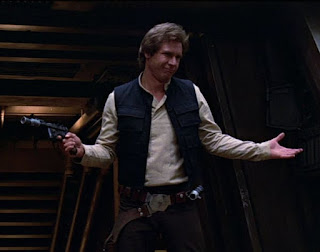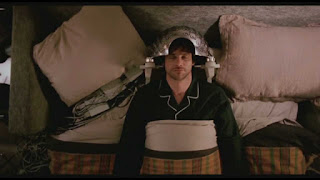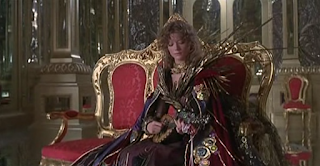***SPOILERS***
I can't decide whether I enjoy this film or that it makes me furious for re-enforcing the very norms that it tries to expel and explore. This is the worst of Kevin Smith's movies in my opinion. At the start it felt like an interesting bro-mance story, turned rom-com, but it quickly diverged into one pseudo-political monologue after another. It's a little "meta" that way.
The film plays out the straight male fantasy that Holden (Ben Affleck) "turns" a gay woman Alyssa into straight (or bisexual). It makes Holden very uncomfortable when he finds out that Alyssa is gay while Banky (Jason Lee) gets along well with her and they laugh about whether lesbian's can really "fuck" without penetration. Banky is clearly homophobic (for both women and men, but particularly men) and appears jealous of Alyssa from the start something that comes out in the end of the film when Holden says to Banky that he's in love with him and that explains why he's so homophobic.
At first it seems that Alyssa is the classic educational role of the lesbian/ woman, trying to explain why women don't 'need' men for sex/ love/ relationships. But their supposed "friendship" builds into a romantic friendship where Holden is clearly in love with Alyssa and he shouts at Banky when he keeps giving him shit about hanging out with her, acting like a jilted lover, but also a sad best friend. Then there comes the scene in the diner where Alyssa wants Holden to hang a painting she bought in his apartment, something that snaps in him as crossing a boundary or line of their friendship into romance. So then Holden makes a long (unrealistically) uninterrupted speech to Alyssa in the car in the rain at night about how much he loves her blah blah. She just leaves the car. When he chases her she repeatedly tells him to fuck off basically, but then in of course the true rom-com nature of the genre she kisses him and they tumble into bed, relationship and love with each other. Alyssa talks about falling in love with him and this strange mash up idea (another speech/ monologue) of unconventionality and why she doesn't rule anyone out and that's the reason she came around to loving Holden. (I also feel there must be a conscious choice to call Affleck's character Holden in reference to Holden Caulfield?!).
Of course the idea of (Holden) being the only man to turn a lesbian (Alyssa) straight comes to a crashing disaster when Banky keeps digging up dirt on her past. At first Holden says it's not true, then that it doesn't bother him and when he finally confronts Alyssa about it he admits that it bothers him. Less than the idea that men want sole sexual ownership of women (that's an all too real stereotype) what bothers me most is Alyssa's response in that she says that it was easier to "let" him believe that he was the only man she had been with sexually instead of being honest and having to repeatedly say he was the thing that she had been searching for in a person. In addition this is made worse by the fact that in being with Holden she has "adjusted" her identity and been "ostracised" by her group of friends (who Banky characterise as "man hating dykes" something the film confirms in the scene where Alyssa's friends accuse her of playing the "pronoun game" by being deliberately ambiguous and says "another one bites the dust").
But it gets worse. Holden thinks that the perfect solution to this is (said in yet another speech) with Alyssa and Banky is that they should all have sex together to basically clear the sexual tension and intimacy and explore things. Banky is relieved when Alyssa says no. Alyssa's response is spot on, she states that it is ridiculous and all the reasons why it would be a bad idea, but mostly because she only wants to be with him. Once again reinforcing the hetero-normative stereotype that only one man and one woman should be together monogamously.
While this film covers some interesting concepts and stereotypes of sexual identity and gender norms, it is ultimately a disappointment.




















































